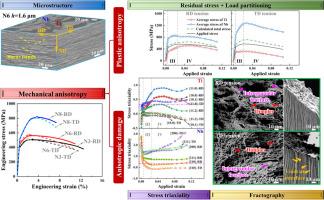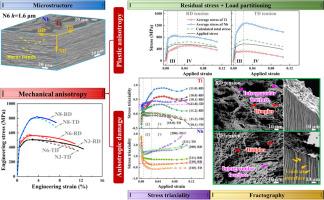Mechanical behavior anisotropy of multilayered metallic composites revealed by in-situ synchrotron X-ray diffraction: Example of Ti/Nb laminates processed by accumulative roll bonding
IF 9.3
1区 材料科学
Q1 MATERIALS SCIENCE, MULTIDISCIPLINARY
引用次数: 0
Abstract
Multilayered metallic composites have attracted widespread attention in both scientific and engineering communities owing to their exceptional mechanical properties. Clarifying the anisotropic mechanical behavior and the underlying deformation mechanisms is the premise for the successful application of those materials. In this study, the anisotropic plasticity and damage of multilayered Ti/Nb composites processed by accumulative roll bonding were investigated using synchrotron-based X-ray diffraction during tensile deformation. When comparing the uniaxial tension along rolling direction (RD) and transverse direction (TD), the laminates do not show obvious plastic anisotropy, but have significant anisotropic neck-to-fracture behavior. Residual stress, along with texture, contributes to the absence of anisotropy in yield strength. Under different loading directions, similar dislocation densities in each constituent metal, resulting from the similar grain morphologies, are responsible for the consistent ultimate tensile strengths. The collective hardening effect of the constituent metals results in the insignificant difference of work hardening in the bulk laminates. After necking, the faster degradation of mechanical property, namely the higher decreasing rate of flow stress, of the bulk composites loaded along the TD is attributed to the larger stress triaxiality of the Nb {211} grains (i.e. 〈211〉 // loading direction) that accelerates micro-void growth in the Nb layers as well as the more universal decohesion of hetero-interfaces between the different metals. These findings provide a comprehensive and in-depth understanding of the anisotropic plasticity and fracture behaviors, as well as the micromechanisms of Ti/Nb composites, which gives new insights to excavate the forming potential for multilayered metallic composites.


原位同步加速器x射线衍射揭示多层金属复合材料力学行为的各向异性:以累积滚接Ti/Nb层合板为例
多层金属复合材料以其优异的力学性能引起了科学界和工程界的广泛关注。澄清材料的各向异性力学行为及其变形机制是这些材料成功应用的前提。利用同步x射线衍射研究了累积轧制复合多层Ti/Nb复合材料在拉伸变形过程中的各向异性塑性和损伤。对比轧制方向(RD)和横向(TD)的单轴拉伸,层合板不表现出明显的塑性各向异性,但具有显著的各向异性颈断裂行为。残余应力和织构共同导致屈服强度不具有各向异性。在不同的加载方向下,由相似的晶粒形貌导致的各成分金属中相似的位错密度是导致最终抗拉强度一致的原因。由于各组成金属的集体硬化效应,使得块体层合板的加工硬化差异不显著。缩颈后,随着Nb{211}晶粒(<211; >)的应力三轴性增大,沿TD加载的块体复合材料的力学性能退化速度更快,即流动应力下降速率更高。//加载方向),加速了Nb层中微空洞的生长,以及不同金属之间异质界面的更普遍的脱黏。这些发现为全面深入地了解Ti/Nb复合材料的各向异性塑性和断裂行为以及微观机制提供了新的思路,为挖掘多层金属复合材料的形成潜力提供了新的思路。
本文章由计算机程序翻译,如有差异,请以英文原文为准。
求助全文
约1分钟内获得全文
求助全文
来源期刊

Acta Materialia
工程技术-材料科学:综合
CiteScore
16.10
自引率
8.50%
发文量
801
审稿时长
53 days
期刊介绍:
Acta Materialia serves as a platform for publishing full-length, original papers and commissioned overviews that contribute to a profound understanding of the correlation between the processing, structure, and properties of inorganic materials. The journal seeks papers with high impact potential or those that significantly propel the field forward. The scope includes the atomic and molecular arrangements, chemical and electronic structures, and microstructure of materials, focusing on their mechanical or functional behavior across all length scales, including nanostructures.
 求助内容:
求助内容: 应助结果提醒方式:
应助结果提醒方式:


